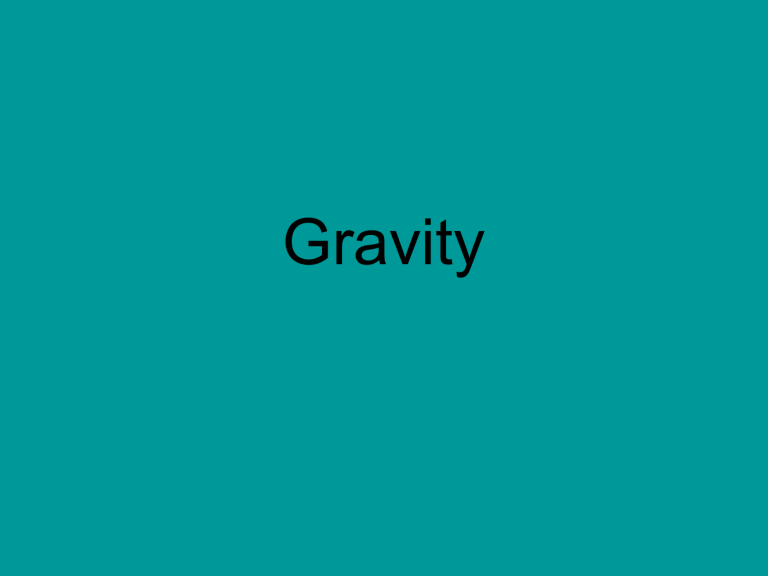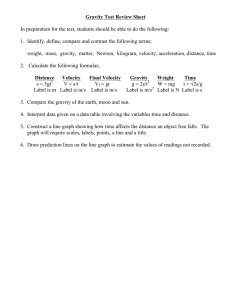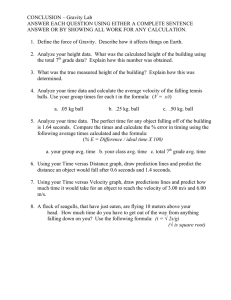Gravity: Universal Gravitation, Free Fall, and Projectile Motion
advertisement

Gravity • Would you be surprised if you let go of a pen you were holding and it did not fall? • You are so used to objects falling that you may not have thought about why they fall. • One person who thought about it was Isaac Newton. • He concluded that a force acts to pull objects straight down toward the center of Earth. • Gravity is a force that pulls objects toward each other. Universal Gravitation • Newton realized that gravity acts everywhere in the universe, not just on Earth. • It is the force that makes an apple fall to the ground. • It is the force that keeps the moon orbiting around Earth. • It is the force that keeps all the planets in our solar system orbiting around the sun. • What Newton realized is now called the law of universal gravitation. • The law of universal gravitation states that the force of gravity acts between all objects in the universe. • This means that any two objects in the universe, without exception, attract each other. • You are attracted not only to Earth but also to all the other objects around you. • Earth and the objects around you are attracted to you as well. • However, you do not notice the attraction among objects because these forces are small compared to the force of Earth’s attraction. Factors Affecting Gravity • Two factors affect the gravitational attraction between objects: – Mass – Distance • • • • • Mass is a measure of the amount of matter in an object. The SI unit of mass is the kilogram. One kilogram is the mass of about 400 modern pennies. Everything that has mass is made up of matter. The more mass an object has, the greater its gravitational force. • Because the sun’s mass is so great, it exerts a large gravitational force on the planets. • That’s one reason why the planets orbit the sun. • In addition to mass, gravitational force depends on the distance between the objects. • The farther apart two objects are, the lesser the gravitational force between them. • For a spacecraft traveling toward Mars, Earth’s gravitational pull decreases as the spacecraft's distance from Earth increases. • Eventually the gravitational pull of Mars becomes greater than Earth’s, and the spacecraft is more attracted toward Mars. Weight and Mass • Mass is sometimes confused with weight. • Mass is a measure of the amount of matter in an object; weight is the measure of the gravitational force exerted on an object. • The force of gravity on a person or object at the surface of a planet is known as weight. • So, when you step on a bathroom scale, you are determining the gravitational force Earth is exerting on you. • Weight varies with the strength of the gravitational force but mass does not. • Suppose you weighed yourself on Earth to be 450 newtons. • Then you traveled to the moon and weighed yourself again. • You might be surprised to find out that you weigh only about 75 newtons – the weight of about 8 kilograms on Earth! • You weigh less on the moon because the moon’s mass is only a fraction of Earth’s. Gravity and Motion • On Earth, gravity is a downward force that affects all objects. • When you hold a book, you exert a force that balances the force of gravity. • When you let go of the book, gravity becomes an unbalanced force and the book falls. Free Fall • When the only force acting on an object is gravity, the object is said to be in free fall. • An object in free fall is accelerating. • Do you know why? • In free fall, the force of gravity is an unbalanced force, which causes an object to accelerate. • How much do objects accelerate as they fall? • Near the surface of Earth, the acceleration due to gravity is 9.8 m/s2. • This means that for every second an object is falling, its velocity increases by 9.8 m/s. • For example, suppose an object is dropped from the top of a building. • Its starting velocity is 0 m/s. • After one second, its velocity has increased to 9.8 m/s. • After two seconds, its velocity is 19.6 m/s (9.8 m/s + 9.8 m/s) • The velocity continues to increase as the object falls. • While it may seem hard to believe at first, all objects in free fall accelerate at the same rate regardless of their masses. • The two falling objects in Figure 10 demonstrate this principle. Air Resistance • Despite the fact that all objects are supposed to fall at the same rate, you know that this is not always the case. • For example, an oak leaf flutters slowly to the ground, while an acorn drops straight down. • Objects falling through air experience a type of fluid friction called air resistance. • Remember that friction acts in the direction opposite to motion, so air resistance is an upward force exerted on falling objects. • Air resistance is not the same for all objects. • Falling objects with a greater surface area experience more air resistance. • That is why a leaf falls more slowly than an acorn. • In a vacuum, where there is no air, all objects fall with exactly the same rate of acceleration. • You can see the effect of air resistance if you drop a flat piece of paper and a crumpled piece of paper at the same time. • Since the flat paper has a greater surface area, it experiences greater air resistance and falls more slowly. • In a vacuum, both pieces of paper would fall at the same rate. • Air resistance increases with velocity. • As a falling object speed up, the force of air resistance becomes greater and greater. • Eventually, a falling object will fall fast enough that the upward force of air resistance becomes equal to the downward force of gravity acting on the object. • At this point the forces on the object are balanced. • Remember that when forces are balanced, there is no acceleration. • The object continues to fall, but its velocity remains constant. • The greatest velocity a falling object reaches is called its terminal velocity. • Terminal velocity is reached when the force of air resistance equals the weight of the object. Projectile Motion • Rather than dropping a ball straight down, what happens if you throw it horizontally? • An object that is thrown is called a projectile. • Will a projectile that is thrown horizontally land on the ground at the same time as an object that is dropped? • The yellow ball was given a horizontal push at the same time as the red ball was dropped. • Even though the yellow ball moves horizontally, the force of gravity continues to act on it in the same way it acts on the red ball. • The yellow ball falls at the same rate as the red ball. • Thus both balls will hit the ground at exactly the same time. • In a similar way, an arrow flying toward a target is a projectile. • Because of the force of gravity, the arrow will fall as it flies toward the target. • So if you try to hit the bull’s-eye, you must aim above it to account for gravity’s pull. • When you throw a projectile at an upward angle, the force of gravity reduces its vertical velocity • Eventually the upward motion of the projectile will stop, and gravity will pull it back toward the ground. • From this point, the projectile will fall at the same rate as any dropped object.






